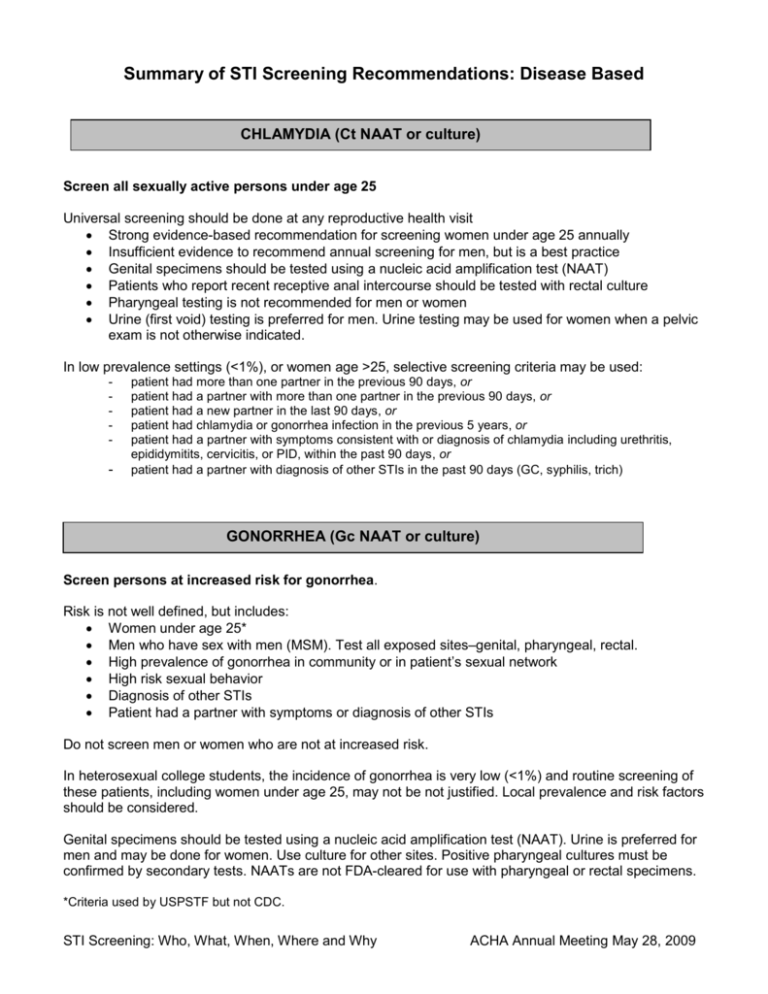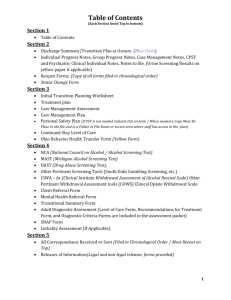
Summary of STI Screening Recommendations: Disease Based
CHLAMYDIA (Ct NAAT or culture)
Screen all sexually active persons under age 25
Universal screening should be done at any reproductive health visit
Strong evidence-based recommendation for screening women under age 25 annually
Insufficient evidence to recommend annual screening for men, but is a best practice
Genital specimens should be tested using a nucleic acid amplification test (NAAT)
Patients who report recent receptive anal intercourse should be tested with rectal culture
Pharyngeal testing is not recommended for men or women
Urine (first void) testing is preferred for men. Urine testing may be used for women when a pelvic
exam is not otherwise indicated.
In low prevalence settings (<1%), or women age >25, selective screening criteria may be used:
-
-
patient had more than one partner in the previous 90 days, or
patient had a partner with more than one partner in the previous 90 days, or
patient had a new partner in the last 90 days, or
patient had chlamydia or gonorrhea infection in the previous 5 years, or
patient had a partner with symptoms consistent with or diagnosis of chlamydia including urethritis,
epididymitits, cervicitis, or PID, within the past 90 days, or
patient had a partner with diagnosis of other STIs in the past 90 days (GC, syphilis, trich)
GONORRHEA (Gc NAAT or culture)
Screen persons at increased risk for gonorrhea.
Risk is not well defined, but includes:
Women under age 25*
Men who have sex with men (MSM). Test all exposed sites–genital, pharyngeal, rectal.
High prevalence of gonorrhea in community or in patient’s sexual network
High risk sexual behavior
Diagnosis of other STIs
Patient had a partner with symptoms or diagnosis of other STIs
Do not screen men or women who are not at increased risk.
In heterosexual college students, the incidence of gonorrhea is very low (<1%) and routine screening of
these patients, including women under age 25, may not be not justified. Local prevalence and risk factors
should be considered.
Genital specimens should be tested using a nucleic acid amplification test (NAAT). Urine is preferred for
men and may be done for women. Use culture for other sites. Positive pharyngeal cultures must be
confirmed by secondary tests. NAATs are not FDA-cleared for use with pharyngeal or rectal specimens.
*Criteria used by USPSTF but not CDC.
STI Screening: Who, What, When, Where and Why
ACHA Annual Meeting May 28, 2009
HEPATITIS B (HbsAg)
Screen for hepatitis B surface antigen in persons at increased risk for infection:
Men who have sex with men
Injection drug users
Persons born in areas with an increased prevalence of hepatitis B (>2%)
Sexual partners of persons with chronic hepatitis B infection
Do not screen persons who are not at increased risk.
Previously immunized persons do not need screening unless they were at risk prior to receiving vaccine.
If so, screen once to rule out chronic infection. Transmission of hepatitis B occurs by both sexual and
percutaneous routes.
HEPATITIS C (HCV antibody EIA)
Screen for hepatitis C antibody in persons with known risk factors for this infection:
Injection drug use (current or past)
Persons who received a transfusion, transplant or blood products prior to 1992
Persons with liver disease of unknown cause (persistently elevated ALT)
Do not screen persons who are not at increased risk.
Transmission of hepatitis C is mostly percutaneous; sexual transmission is rare. Some guidelines
recommend screening MSM regardless of drug use history, but there is no data to support this.
HERPES (HSV-2 gG antibody ELISA)
Routine screening for herpes in adults or adolescents is not recommended.
Some organizations and experts recommend that providers consider screening persons at higher risk of
having genital herpes including:
Sexual partners of persons with known genital herpes infection
Men who have sex with men
Pregnant women
Persons with HIV infection
HSV prevalence increases with age and the number of lifetime sexual partners. Testing is more useful
when the prior probability of having herpes is high. The prevalence of HSV-2 in young adults under age
25 is less than 10%. In this population, the positive predictive value of a type-specific antibody test is less
than 50%. Equivocal antibody tests with EIA values <3.0 should be repeated using a alternate screening
test and/or confirmed by Western blot.
Screening should be done using only type-specific (glycoprotein G based) serologic tests.
STI Screening: Who, What, When, Where and Why
ACHA Annual Meeting May 28, 2009
HIV (HIV 1/2 antibody EIA)
Screen all sexually active adults for HIV antibody.
Persons at increased risk should be screened annually:
Men who have sex with men
Injection drug users
Persons exchanging sex for money or drugs
Persons who have had multiple sex partners since their most recent HIV test
Sexual partners of any of these patients
CDC recommends HIV testing for all patients seeking treatment for an STD regardless of known or
suspected risk. Reactive antibody tests must be confirmed by Western blot.
HUMAN PAPILLOMAVIRUS (High Risk HPV DNA)
Routine screening of adults for HPV infection is not recommended.
Per ASCCP Guidelines, a high-risk HPV DNA test may be used as an adjunct to cervical cytology in
women age 30 and older. This test is not approved for screening use in women under age 30.
SYPHILIS (RPR OR VDRL)
Screen women and men who are at increased risk for syphilis:
Men who have sex with men
Injection drug users
Persons exchanging sex for money or drugs
Sexual partners of any of these patients
Screen pregnant women at the first prenatal visit
Do not screen men or women who are not at increased risk
The prevalence of syphilis in college students is very low (0.1%); routine screening is probably not
justified except for MSM. Local prevalence and risk factors should be considered. A reactive screening
test must be confirmed with the TP-PA test or equivalent.
TRICHOMONIASIS (Wet Prep or PCR)
No recommendation
There are no published recommendations regarding screening of asymptomatic women or men for
trichomoniasis. Incidence is estimated to be high but varies by population. Local prevalence and risk
factors should be considered.
STI Screening: Who, What, When, Where and Why
ACHA Annual Meeting May 28, 2009
Summary of STI Screening Recommendations: Patient Based
ALL PATIENTS
Obtain a basic sexual history to include
Partners: # partners last 90 days and gender of those partners
Practices: sites of sexual contact (oral, genital, vaginal, anal), injection drug use
Protection: frequency of condom use
Past History: previous STDs
Prevention of Pregnancy: contraception use if pregnancy not desired
Genital exam to assess for lesions/warts (optional)
WOMEN WITH MALE PARTNERS (WSM)
Chlamydia NAAT (cervical swab or first void urine)
Gonorrhea NAAT, if increased risk (cervical swab or first void urine)
HIV antibody (if not previously tested, or recent risk factors)
Syphilis (VDRL or RPR) only if at increased risk
MEN WITH FEMALE PARTNERS (MSW)
Chlamydia NAAT (first void urine)
Gonorrhea NAAT, if increased risk (first void urine)
HIV antibody (if not previously tested, or recent risk factors)
WOMEN WITH FEMALE PARTNERS (WSW)
Chlamydia and gonorrhea tests (cervical or urine) if history of male partners
Syphilis and HIV antibody tests if at increased risk (male partners, IDU)
MEN WITH MALE PARTNERS (MSM)
Chlamydia NAAT (first void urine)
Gonorrhea NAAT (first void urine)
Chlamydia culture (rectal) if recent receptive anal intercourse
Gonorrhea culture (rectal) if recent receptive anal intercourse
Gonorrhea culture (pharynx)
Syphilis serology (RPR or VDRL)
HIV antibody test
Hepatitis B surface antigen (if not immunized prior to onset of sexual activity)
STI Screening: Who, What, When, Where and Why
ACHA Annual Meeting May 28, 2009
References (topic area highlighted)
United States Preventive Services Task Force. USPSTF Recommendations for STI Screening. Am Fam Phys
2008;77(6):819-24.
Guide to Clinical Preventive Services, 2008. Recommendations of the U.S. Preventive Services Task Force.
Agency for Healthcare Research and Quality, Rockville, MD. http://www.ahrq.gov/clinic/pocketgd.htm
Meyers DS et al. Screening for Chlamydia Infection: An Evidence Update for the U.S. Preventive Services Task
Force. Ann Intern Med 2007;147:135-42.
CDC. Male Chlamydia Screening Consultation – Meeting Report May 22, 2007. Available online at:
http://www.cdc.gov/std/chlamydia/ChlamydiaScreening-males.pdf
CDC. Screening Tests to Detect Chlamydia trachomatis and Neisseria gonorrhoeae Infections-2002. MMWR
2002;51(rr15):1-38.
Maloney SK, Johnson C. Why Screen for Chlamydia? An Implementation Guide for Healthcare Providers.
Partnership for Prevention, Washington DC. 2008. Available online at http://www.prevent.org/templates/ncchome/download/whyscreenforchlamydia.pdf
California Chlamydia Action Coalition. Chlamydia Screening & Treatment Practice Guidelines, 2002. Available
online at: http://www.igh.org/castd/downloadable/clinicalpractice_guidelines.pdf
James AB, Simpson TY, Chamberlain WA. Chlamydia Prevalence Among College Students: Reproductive and
Public Health Implications. Sex Trans Dis 2008;35(6):529-32.
Smith PD, Roberts CM. American College Health Association Annual Pap Test and Sexually Transmitted
Infection Survey: 2006. J Am Coll Health 2009;57(4):389-94.
CDC. Recommendations for Identification and Public Health Management of Persons with Chronic Hepatitis B
Virus Infection MMWR 2008;57 (No. RR–8).
CDC. Revised Recommendations for HIV Testing of Adults, Adolescents, and Pregnant Women in Health-Care
Settings. MMWR 2006;55(No. RR-14).
Bartlett JG et al. Opt-Out Testing for Human Immunodeficiency Virus in the United States: Progress and
Challenges. JAMA 2008;300(8):945-951.
CDC. Recommendations for Prevention and Control of Hepatitis C Virus (HCV) Infection and HCV-Related
Chronic Disease. MMWR 1998;47(No. RR-19).
Handsfield HH. Resurgent Sexually Transmitted Diseases Among Men Who Have Sex With Men: Screening
Guidelines for STD/HIV Prevention. Medscape Infectious Diseases 2001;3(2). Available at:
http://www.medscape.com/viewarticle/408301
Gunn RA, O’Brien CJ, Lee MA, Gilchick RA. Gonorrhea Screening Among Men Who Have Sex With Men: Value
of Multiple Anatomic Site Testing, San Diego, California, 1997-2003. Sex Trans Dis 2008;35(10):845:48.
Buffington J, et al. Low Prevalence of Hepatitis C Virus Antibody in Men Who Have Sex with Men Who Do Not
Inject Drugs. Pub Health Reports 2007;122(S2):63-67.
Guery SL et al. Recommendations for the Selective Use of Herpes Simplex Virus Type 2 Serologic Tests. Clin
Infect Dis 2005;40(1):38-45.
Hayley DM et al. Performance of Focus ELISA Tests for HSV-1 and HSV-2 Antibodies Among University Students
With No History of Genital Herpes. Sex Trans Dis 2007;34(9):681-85.
STI Screening: Who, What, When, Where and Why
ACHA Annual Meeting May 28, 2009
Resources
Sexually Transmitted Diseases Treatment Guidelines, 2006.
Standard reference guide for STD treatment from the Centers for Disease Control and Prevention
www.cdc.gov/std/treatment/
National Center for HIV/STD/TB Prevention, Division of STD Prevention
Primary CDC portal site for STD information, for providers and patients
www.cdc.gov/std/
California Chlamydia Action Coalition
Comprehensive site with links to resources and guidelines. Includes a downloadable cost-effectiveness
program to determine costs and benefits of chlamydia screening in managed care organizations.
www.ucsf.edu/castd/chlamydia_coalition.html
CDC National Prevention Information Network
STD Resource page of NPIN, a service of the National Center for HIV, STD and TB Prevention at
CDC. Links to databases, publications and other resources.
www.cdcnpin.org/std/start.htm
Summary Guidelines for the Use of Herpes Simples Virus (HSV) Type 2 Serologies
Useful guide covering herpes screening from the California STD Controllers Association
www.stdhivtraining.org
STD Checkup – Screen, Diagnose, Treat, & Prevent: A Clinician’s Resource for STDs in Gay Men
and Other MSM
California Dept of Public Health site with recommendations, protocols, guidelines, patient materials.
www.stdcheckup.org/provider/index.html
CDC - Infertility Prevention Project
Major CDC initiative focused on screening and treatment of chlamydia and gonorrhea. Provides funding
for testing programs in many family planning clinics. Source for state and regional chlamydia data.
www.cdc.gov/std/infertility/ipp.htm
National Chlamydia Coalition
CDC-sponsored coalition of non-profit organizations, professional associations, advocacy groups, and
government representatives dedicated to elevating the importance of chlamydia screening and
treatment. Website includes screening toolkit, policy guidelines, patient and provider resources.
www.prevent.org/NCC.
American Social Health Association
Nonprofit organization dedicated to preventing STDs. Quality patient resources and materials.
www.ashastd.org
Cincinnati STD/HIV Training Center
CDC Region V (upper Midwest) designated site for provider training. Offers health professionals a
spectrum of educational opportunities to increase knowledge and skills in the areas of sexual and
reproductive health. Classroom, clinic and distance learning options.
http://www.stdptc.uc.edu/
STI Screening: Who, What, When, Where and Why
ACHA Annual Meeting May 28, 2009




